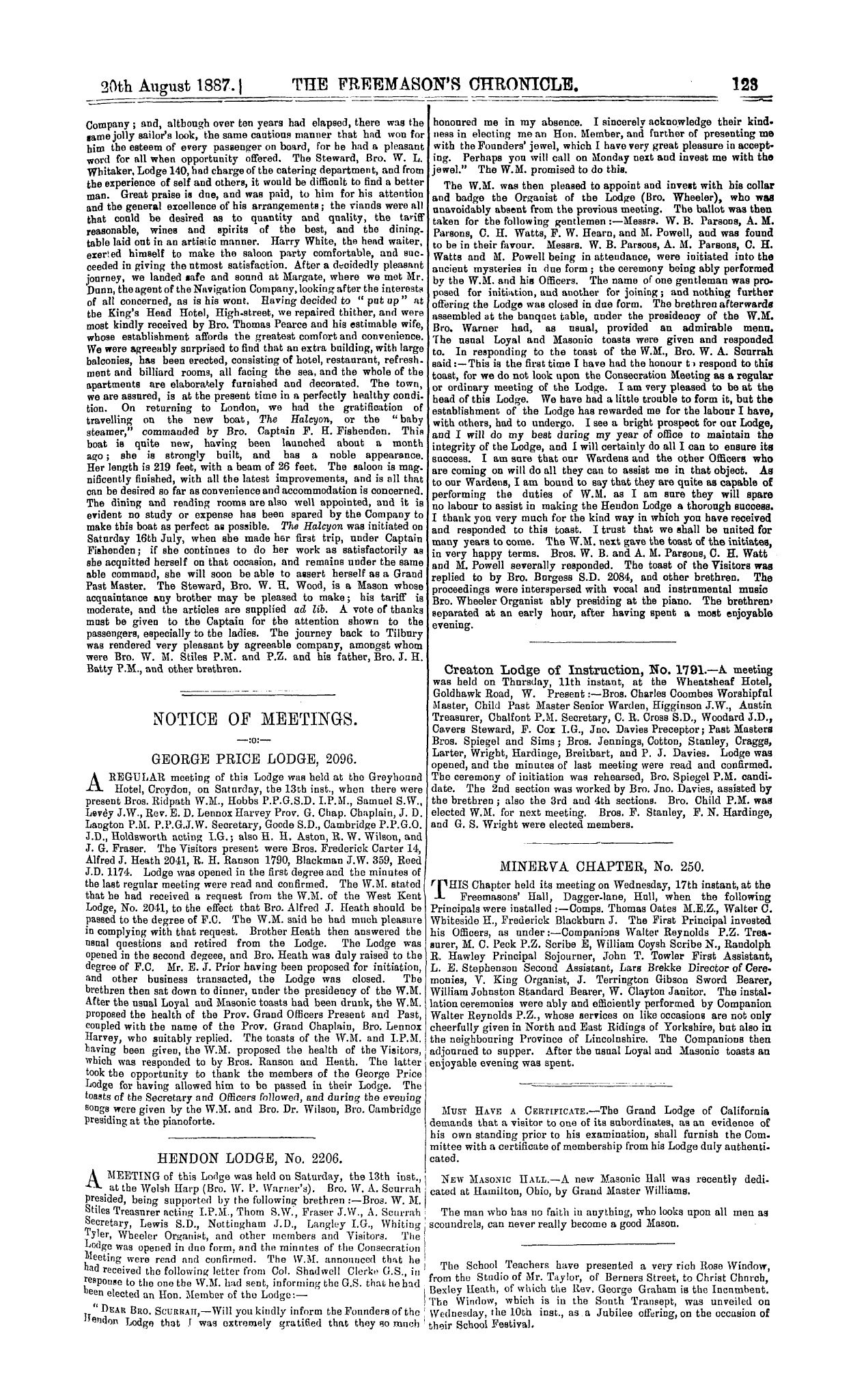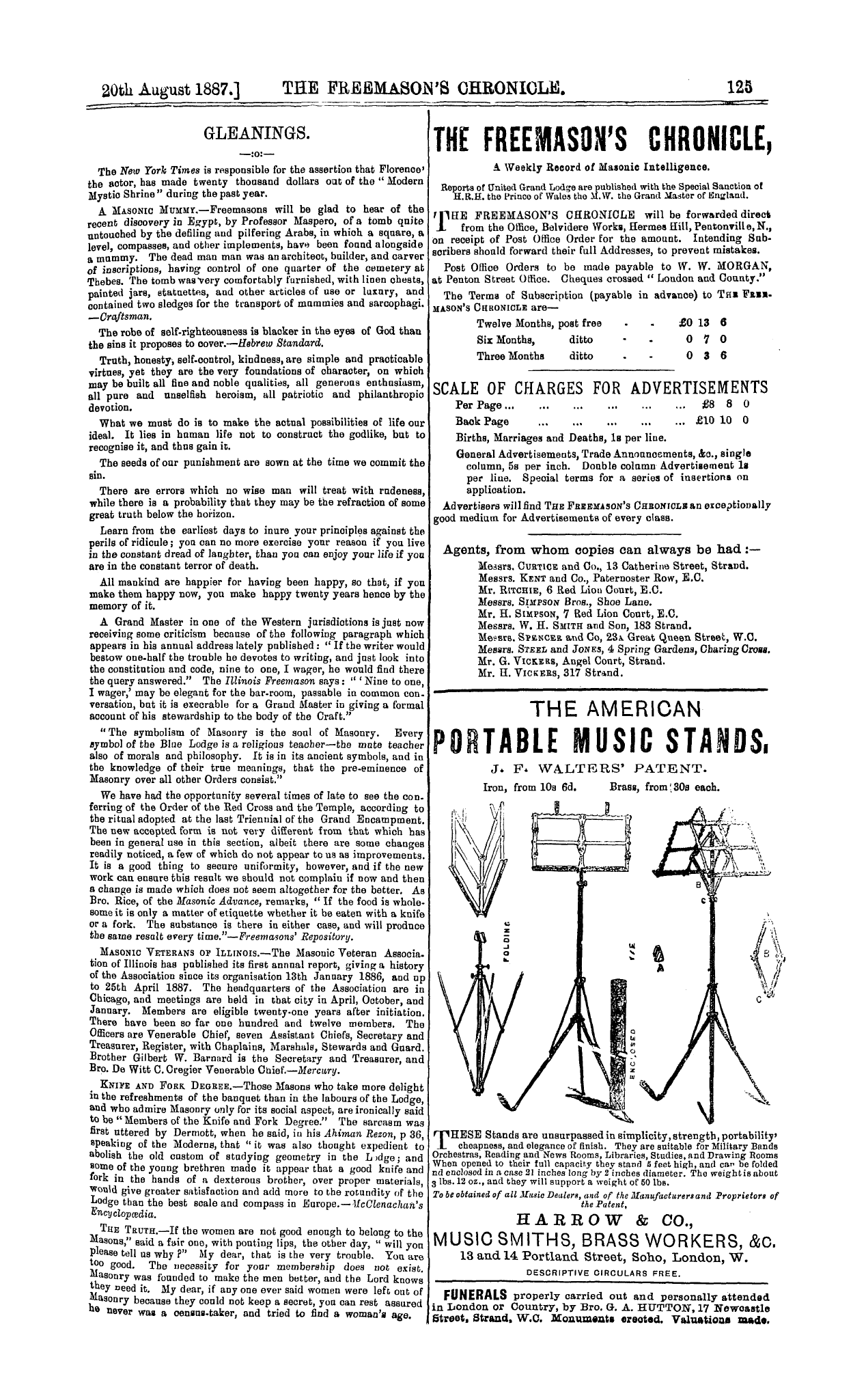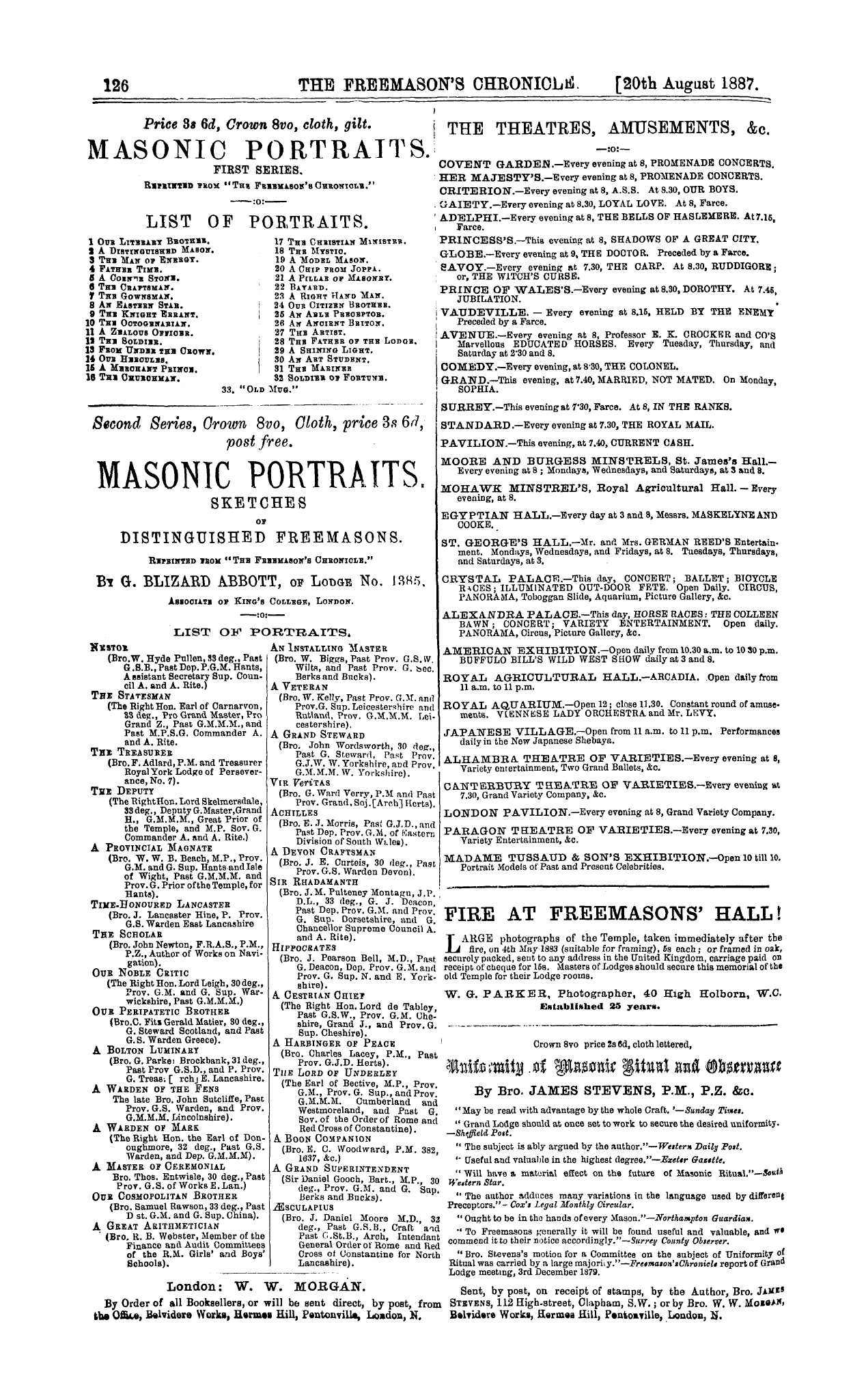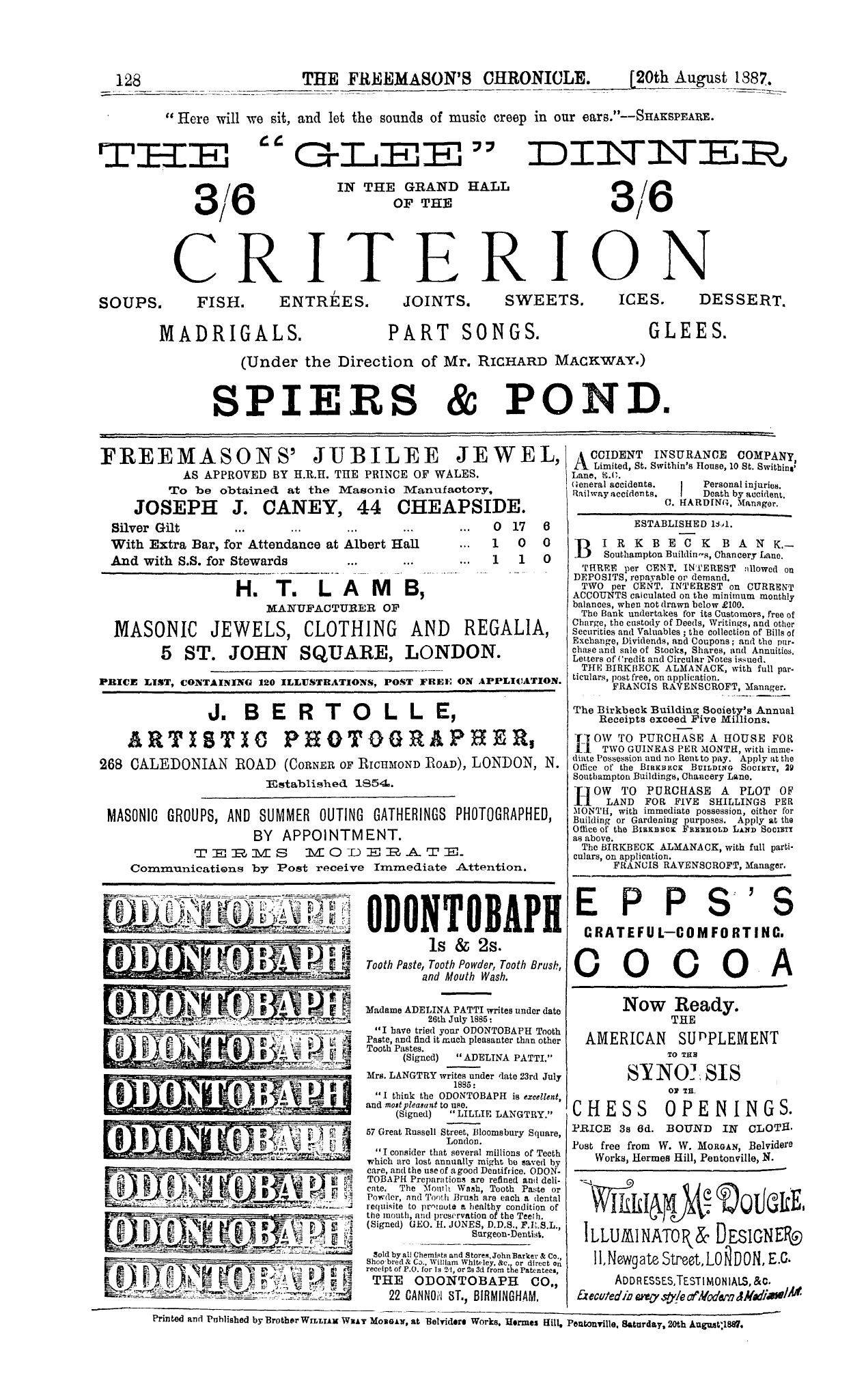-
Articles/Ads
Article MY RECENT TUSSLE WITH BRO. LANE. ← Page 2 of 3 Article MY RECENT TUSSLE WITH BRO. LANE. Page 2 of 3 →
Note: This text has been automatically extracted via Optical Character Recognition (OCR) software.
My Recent Tussle With Bro. Lane.
the Grand Lodge of the Ancients in 1754 , Bro . Gould Bays : — " Several Lodges in arrears were declared vacant , and a minute of 2 nd October introduces us to a practice , unknown I believe under any other Masonic jurisdiction . It runs
thus : —Bro . Cowen , Master of Lodge No . 37 , proposed to pay one guinea into the Grand Lodge Fund for No . ( 3 ( now vacant ) . This proposition was accepted , and the brethren of No . 37 are to rank as No . 6 for ye future . " We see now that while Bro . Gould believes that the
practice of assigning the numbers of extinct Lodges to new ones originated among the Ancients in 1754 , Brother Lane says that the practice originated among the Moderns as early as 1732 . " Who shall decide when doctors
disagree ?" With regard to the question of erased Lodges and restored Lodges , Bro . Gould says that between 4 th June 1742
and 30 th November 1752 forty-five Lodges were erased in London , four surrendered their charters , besides which another London Lodge was erased in 1752 , and at the same time no less than twenty-one country Lodges were
blotted out from the list ; three of these were afterwards restored , for reasons which will be given hereafter . Bro . Crould , however , did not notice that within the first four months of 1737 no less than fourteen Lodges were erased ,
three of which were restored before 1740 . Now , my reason for supposing that some of the Lodges erased in 1737 were not erased for violating the law of 1735 , but were punished for disobedience , was based upon the fact
that the Grand Lodge meeting of 11 th December 1735 broke up in a regular row . Hence it is not improbable that the three Lodges were erased in 1737 , and were restored before 1740 may have been erased for rebellion , and
not for violating the law of 24 th December 1735 . And to show further that the said law of February 1735 was not a dead letter , I will give the following , from Bro . Lane ' s
own book . He , after quoting the said Jaw in full , viz ., that when a Lodge ceased to meet for twelve successive months , its rank and old number should never be restored to it , goes on to
say" Apparently this decision was acted upon in many cases , but some Lodges that were erased were reinstated in their old positions . A distinct case of refusal to do this was recorded in the Grand Lodge minutes of 16 th of March
1752 , when No . 83 * * * prayed to be restored . On debate it was moved that the law made on the 24 th day of February 1734 [ Old style ] might be read , and the same
being read , and it thereby appearing that a Lodge erased must lose its former rank and submit to a new Constitution , —Ordered that the said petition be rejected . "
Bro . Gould gives some interesting information about four erased Lodges . 1 st . Original Lodge No . 4 , of 1717 , was successively changed , in 1729 and 1740 , into No . 3 and No . 2—
" On 3 rd April 1747 [ says Bro . Gould ] it was erased from the List for non-attendance at the Quarterly Communications , but was restored to its place 4 th September 1751 . According to official records Bro . Lediard informed
the brethren that the Bt . Wor . Bro . Payne , late Grand Master , and several other members of the Lodge , lately held at the Horn , Palace Tard , Westminster , had been very successful in their endeavours to serve the said Lodge ,
and that they were ready to pay two guineas to the use of the Grand Charity , and therefore moved that out of respect to Bro . Payne ( who was then present ) and several
other Past Grand Masters who were members thereof , the said Lodge might be restored , and have its former rank and place in the List of Lodges ; which was ordered accordingly . " ( Gould ' s History , Vol . IV ., pp 343-4 ) .
Here was a decided violation of the law of 24 th February 1735 , but no one will feel surprised thereat , and no one will disapprove of the action of the Grand Lodge , when all things are taken into consideration , but this departure from
the old rule proves that the old rule was in full force , and that the Horn Lodge restoration was simply a solitary exception to that rule , and the next case of the same nature confirms my belief , that the Grand Lodge of England was
opposed to assign to a new organization the number of an extinct Lodge . It seems that , encouraged by the Buccess of the original No . 4 Lodge in 1751 , a number of
brethren undertook to have themselves established as original No . 2 . Accordingly , they assembled at the publichouse where the old Lodge used to meet , and petitioned the Grand Lodge to call the assembly Lodge No . 2 . Bro . Gould says : —
My Recent Tussle With Bro. Lane.
" Original No . 2 . In 1730 , met at the Ball and Gate , Hoi . born . It appeared for the last time in the List of 1736 . It wasstrnok off the roll at the renumbering of the Lodges in 1740 ; and
application for its restoration was mode in 1752 , baton the ground that none of the petitioners had over been members of that Lodge , it was rejected . " Vol . IV ., p 340 .
Bro . Gould gives but two more Lodges that were restored , viz .: No . 9 , erased 25 th March 1745 , was restored 7 th March 1747 . It appearing that the non-attendance was
occasioned by mistake , and No . 54 , erased 21 st November 1745 , was restored 4 th September 1751 . It appearing that their not meeting regularly , had been occasioned by unavoidable accidents . Vol . IV ., p 399 .
If I understand rightly , the above are the only instances explained in the Records as to why and wherefore some Lodges were restored , and why some were refused
restoration , and thus far I find no intimation of an entire new Lodge having had an old number of an extinct Lodge assigned to it by the Grand Lodge .
" But , " says Bro . Lane , " if Bro . Norton will kindly read the preface to the ' Masonic Records' ( pp xvii . and xix . ) , he will discover several instances of this very thing . I can srive here one onlv : —
"An entire new Lodge at Wolverhampton paid the usual £ 2 2 s in 1768 for its Warrant , the number of which should have been 433 , but influences operated to procure for it
the No . 77 , which had then recently been vacated by a Gateshead Lodge , whereby this new Lodge , not warranted until 5 th November 1768 , thenceforth took the number and position of a Lodge of 8 th March 1735 . "
Now , my good Bro . Lane , I beg to inform you that between 1756 and 1767 , the latter part of the 24 th February 1735 law , which debarred the Grand Lodge from
restoring to its original rank and number a Lodge that ceased to meet for twelve months , was struck out , aud instead thereof the following was substituted , viz .:
—" And if they [ the members of the Lodge ] petition to bo again inserted and owned as a regular Lodge , they shall , on paying two guineas for a Constitution and two guineas to the Public Charity , be admitted into their former place and rank for presidency . "
Now , with the above law , Bro . Lane s puzzle may easily be solved . It is highly probable that , in 1768 , some Wolverhampton Masons were ambitious of belonging to an old Lodge ; they heard of the erasure of the Gateshead
Lodge , and as there was a means of having it restored , it was agreed between the parties interested for the Gateshead brethren to petition the Grand Lodge for its restoration , aud for the Wolverhampton Masons to pay £ 4 4 s
for the Charter and Charity Fund . This having been accomplished , Lodge No . 77 was opened by its old Officers , when seven brethren were unanimously admitted as members : the Lodge then went into an election of Officers , and the
Officers were unanimously chosen from the new members ; a vote was next taken to remove the Lodge to Wolverhampton , which was carried unanimously . True , the old members then resigned , but yet the members that remained
were the legal continuators of the old Lodge ; it is immaterial whether all the members—old aud new , were conjointly affiliated members of the Lodge for a month , or for an hour , as long as they were once linked together
in membership , it legally continued the same Lodge after the old members left it , and its removal to Wolverhampton made the Lodge no more new than if it had not been removed from Gateshead . The new charter , was merely a
confirmatory warrant , it healed the gap that intervened between its closing and re-opening ; by such a method thirty other Lodges may have been reinstated , but always providing that the members of the Lodge petitioned for its restoration .
Bro . Lane , in the pages of his " Masonic Records" he referred me to furnishes many instances of blunders made by Lodge List makers , where , owing to then * ignorance or mistakes about certain months , it is
questionable as to whether they belonged to one year or another . Hence , a Lodge constituted , say in January 1730 , may have been placed as a 1729 Lodge , or vice versa . Some blunders were caused by a Lodge constituted by a Provincial Grand
Master in America , which was not reported till many years after it was constituted ; but he has nowhere proved that an old number of an extinct Lodse was ever conferred
upon an entire new body of Masons , either before the 1735 law was enacted , or during the continuance , or even after the said law was modified in the 1767 Constitution-In short , Bro . Lane has not proved that the law of 27 tn December 1727 , viz . : that " The precedency of Lodges u
Note: This text has been automatically extracted via Optical Character Recognition (OCR) software.
My Recent Tussle With Bro. Lane.
the Grand Lodge of the Ancients in 1754 , Bro . Gould Bays : — " Several Lodges in arrears were declared vacant , and a minute of 2 nd October introduces us to a practice , unknown I believe under any other Masonic jurisdiction . It runs
thus : —Bro . Cowen , Master of Lodge No . 37 , proposed to pay one guinea into the Grand Lodge Fund for No . ( 3 ( now vacant ) . This proposition was accepted , and the brethren of No . 37 are to rank as No . 6 for ye future . " We see now that while Bro . Gould believes that the
practice of assigning the numbers of extinct Lodges to new ones originated among the Ancients in 1754 , Brother Lane says that the practice originated among the Moderns as early as 1732 . " Who shall decide when doctors
disagree ?" With regard to the question of erased Lodges and restored Lodges , Bro . Gould says that between 4 th June 1742
and 30 th November 1752 forty-five Lodges were erased in London , four surrendered their charters , besides which another London Lodge was erased in 1752 , and at the same time no less than twenty-one country Lodges were
blotted out from the list ; three of these were afterwards restored , for reasons which will be given hereafter . Bro . Crould , however , did not notice that within the first four months of 1737 no less than fourteen Lodges were erased ,
three of which were restored before 1740 . Now , my reason for supposing that some of the Lodges erased in 1737 were not erased for violating the law of 1735 , but were punished for disobedience , was based upon the fact
that the Grand Lodge meeting of 11 th December 1735 broke up in a regular row . Hence it is not improbable that the three Lodges were erased in 1737 , and were restored before 1740 may have been erased for rebellion , and
not for violating the law of 24 th December 1735 . And to show further that the said law of February 1735 was not a dead letter , I will give the following , from Bro . Lane ' s
own book . He , after quoting the said Jaw in full , viz ., that when a Lodge ceased to meet for twelve successive months , its rank and old number should never be restored to it , goes on to
say" Apparently this decision was acted upon in many cases , but some Lodges that were erased were reinstated in their old positions . A distinct case of refusal to do this was recorded in the Grand Lodge minutes of 16 th of March
1752 , when No . 83 * * * prayed to be restored . On debate it was moved that the law made on the 24 th day of February 1734 [ Old style ] might be read , and the same
being read , and it thereby appearing that a Lodge erased must lose its former rank and submit to a new Constitution , —Ordered that the said petition be rejected . "
Bro . Gould gives some interesting information about four erased Lodges . 1 st . Original Lodge No . 4 , of 1717 , was successively changed , in 1729 and 1740 , into No . 3 and No . 2—
" On 3 rd April 1747 [ says Bro . Gould ] it was erased from the List for non-attendance at the Quarterly Communications , but was restored to its place 4 th September 1751 . According to official records Bro . Lediard informed
the brethren that the Bt . Wor . Bro . Payne , late Grand Master , and several other members of the Lodge , lately held at the Horn , Palace Tard , Westminster , had been very successful in their endeavours to serve the said Lodge ,
and that they were ready to pay two guineas to the use of the Grand Charity , and therefore moved that out of respect to Bro . Payne ( who was then present ) and several
other Past Grand Masters who were members thereof , the said Lodge might be restored , and have its former rank and place in the List of Lodges ; which was ordered accordingly . " ( Gould ' s History , Vol . IV ., pp 343-4 ) .
Here was a decided violation of the law of 24 th February 1735 , but no one will feel surprised thereat , and no one will disapprove of the action of the Grand Lodge , when all things are taken into consideration , but this departure from
the old rule proves that the old rule was in full force , and that the Horn Lodge restoration was simply a solitary exception to that rule , and the next case of the same nature confirms my belief , that the Grand Lodge of England was
opposed to assign to a new organization the number of an extinct Lodge . It seems that , encouraged by the Buccess of the original No . 4 Lodge in 1751 , a number of
brethren undertook to have themselves established as original No . 2 . Accordingly , they assembled at the publichouse where the old Lodge used to meet , and petitioned the Grand Lodge to call the assembly Lodge No . 2 . Bro . Gould says : —
My Recent Tussle With Bro. Lane.
" Original No . 2 . In 1730 , met at the Ball and Gate , Hoi . born . It appeared for the last time in the List of 1736 . It wasstrnok off the roll at the renumbering of the Lodges in 1740 ; and
application for its restoration was mode in 1752 , baton the ground that none of the petitioners had over been members of that Lodge , it was rejected . " Vol . IV ., p 340 .
Bro . Gould gives but two more Lodges that were restored , viz .: No . 9 , erased 25 th March 1745 , was restored 7 th March 1747 . It appearing that the non-attendance was
occasioned by mistake , and No . 54 , erased 21 st November 1745 , was restored 4 th September 1751 . It appearing that their not meeting regularly , had been occasioned by unavoidable accidents . Vol . IV ., p 399 .
If I understand rightly , the above are the only instances explained in the Records as to why and wherefore some Lodges were restored , and why some were refused
restoration , and thus far I find no intimation of an entire new Lodge having had an old number of an extinct Lodge assigned to it by the Grand Lodge .
" But , " says Bro . Lane , " if Bro . Norton will kindly read the preface to the ' Masonic Records' ( pp xvii . and xix . ) , he will discover several instances of this very thing . I can srive here one onlv : —
"An entire new Lodge at Wolverhampton paid the usual £ 2 2 s in 1768 for its Warrant , the number of which should have been 433 , but influences operated to procure for it
the No . 77 , which had then recently been vacated by a Gateshead Lodge , whereby this new Lodge , not warranted until 5 th November 1768 , thenceforth took the number and position of a Lodge of 8 th March 1735 . "
Now , my good Bro . Lane , I beg to inform you that between 1756 and 1767 , the latter part of the 24 th February 1735 law , which debarred the Grand Lodge from
restoring to its original rank and number a Lodge that ceased to meet for twelve months , was struck out , aud instead thereof the following was substituted , viz .:
—" And if they [ the members of the Lodge ] petition to bo again inserted and owned as a regular Lodge , they shall , on paying two guineas for a Constitution and two guineas to the Public Charity , be admitted into their former place and rank for presidency . "
Now , with the above law , Bro . Lane s puzzle may easily be solved . It is highly probable that , in 1768 , some Wolverhampton Masons were ambitious of belonging to an old Lodge ; they heard of the erasure of the Gateshead
Lodge , and as there was a means of having it restored , it was agreed between the parties interested for the Gateshead brethren to petition the Grand Lodge for its restoration , aud for the Wolverhampton Masons to pay £ 4 4 s
for the Charter and Charity Fund . This having been accomplished , Lodge No . 77 was opened by its old Officers , when seven brethren were unanimously admitted as members : the Lodge then went into an election of Officers , and the
Officers were unanimously chosen from the new members ; a vote was next taken to remove the Lodge to Wolverhampton , which was carried unanimously . True , the old members then resigned , but yet the members that remained
were the legal continuators of the old Lodge ; it is immaterial whether all the members—old aud new , were conjointly affiliated members of the Lodge for a month , or for an hour , as long as they were once linked together
in membership , it legally continued the same Lodge after the old members left it , and its removal to Wolverhampton made the Lodge no more new than if it had not been removed from Gateshead . The new charter , was merely a
confirmatory warrant , it healed the gap that intervened between its closing and re-opening ; by such a method thirty other Lodges may have been reinstated , but always providing that the members of the Lodge petitioned for its restoration .
Bro . Lane , in the pages of his " Masonic Records" he referred me to furnishes many instances of blunders made by Lodge List makers , where , owing to then * ignorance or mistakes about certain months , it is
questionable as to whether they belonged to one year or another . Hence , a Lodge constituted , say in January 1730 , may have been placed as a 1729 Lodge , or vice versa . Some blunders were caused by a Lodge constituted by a Provincial Grand
Master in America , which was not reported till many years after it was constituted ; but he has nowhere proved that an old number of an extinct Lodse was ever conferred
upon an entire new body of Masons , either before the 1735 law was enacted , or during the continuance , or even after the said law was modified in the 1767 Constitution-In short , Bro . Lane has not proved that the law of 27 tn December 1727 , viz . : that " The precedency of Lodges u















